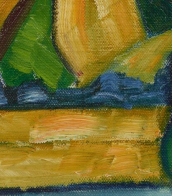георг шольц (1890 - 1945)

Georg Scholz is a German painter and a vivid representative of the New Objectivity movement.
Scholz studied painting at the Karlsruhe Academy of Fine Arts and continued his studies in Berlin with Lovis Korint. After serving in the army in World War I from 1915 to 1918, he returned to painting in the style of Cubism and Futurism. Scholz's entry into the German Communist Party is reflected in his paintings, which sharply and sarcastically criticize the social and economic order of post-war Germany.
Georg Scholz very soon became one of the leaders of the New Realism, a group of artists who practiced the most cynical form of realism. In 1925 he received a professorship at the State Academy of Art in Karlsruhe. In 1926 he began collaborating with the satirical magazine Simplicissimus, and in 1928 he visited Paris.
After Hitler and the National Socialists came to power in Germany in 1933, Scholz immediately lost his teaching job. His work was declared degenerate art, his works were withdrawn from collections in 1937, and the artist himself was banned from painting in 1939.


Georg Scholz is a German painter and a vivid representative of the New Objectivity movement.
Scholz studied painting at the Karlsruhe Academy of Fine Arts and continued his studies in Berlin with Lovis Korint. After serving in the army in World War I from 1915 to 1918, he returned to painting in the style of Cubism and Futurism. Scholz's entry into the German Communist Party is reflected in his paintings, which sharply and sarcastically criticize the social and economic order of post-war Germany.
Georg Scholz very soon became one of the leaders of the New Realism, a group of artists who practiced the most cynical form of realism. In 1925 he received a professorship at the State Academy of Art in Karlsruhe. In 1926 he began collaborating with the satirical magazine Simplicissimus, and in 1928 he visited Paris.
After Hitler and the National Socialists came to power in Germany in 1933, Scholz immediately lost his teaching job. His work was declared degenerate art, his works were withdrawn from collections in 1937, and the artist himself was banned from painting in 1939.


Georg Scholz is a German painter and a vivid representative of the New Objectivity movement.
Scholz studied painting at the Karlsruhe Academy of Fine Arts and continued his studies in Berlin with Lovis Korint. After serving in the army in World War I from 1915 to 1918, he returned to painting in the style of Cubism and Futurism. Scholz's entry into the German Communist Party is reflected in his paintings, which sharply and sarcastically criticize the social and economic order of post-war Germany.
Georg Scholz very soon became one of the leaders of the New Realism, a group of artists who practiced the most cynical form of realism. In 1925 he received a professorship at the State Academy of Art in Karlsruhe. In 1926 he began collaborating with the satirical magazine Simplicissimus, and in 1928 he visited Paris.
After Hitler and the National Socialists came to power in Germany in 1933, Scholz immediately lost his teaching job. His work was declared degenerate art, his works were withdrawn from collections in 1937, and the artist himself was banned from painting in 1939.






